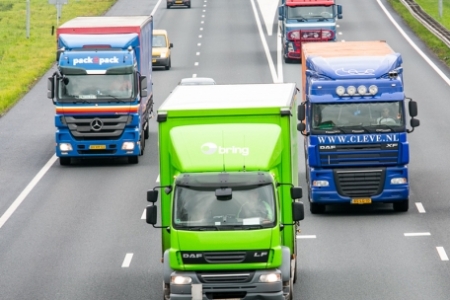Important contributory factors of crashes with trucks and delivery vans are the driver’s age, fatigue, distraction and task load, burst tyres, unbalanced or too heavy vehicle loads, and other road users’ insufficient awareness of truck characteristics.
Age
Young, novice drivers have a higher crash risk than older, more experienced drivers (see SWOV fact sheet 18- to 24-year-olds: young drivers. This particularly applies to drivers of delivery vans. Starren et al. [16] conclude that drivers of delivery vans are often young, have little driving experience and have a higher risk acceptance. Bos and Twisk [17] find that young novice drivers of delivery vans are more often involved in crashes with oncoming traffic, in which the front of the delivery van hits the crash opponent. They are also more often involved in rear-end crashes in which the delivery van is hit from behind; possibly because of unpredictable behaviour.
Fatigue
There are indications that truck drivers are relatively more often involved in fatigue-related crashes than car drivers ([18] [19] [20]; also see SWOV fact sheet Fatigue). Questionnaire studies have found that falling asleep behind the wheel is related to a truck driver’s personal characteristics, such as poor physical fitness and overweight [20] and with working conditions, such as driving long uninterrupted hours and not having a permanent employment contract [21]. The Dutch Safety Board notes that a lack of adequate rest facilities along motorways contributes to driving too many hours, which may lead to fatigue [22].
Distraction and task load
Drivers of trucks and delivery vans are often held to a tight schedule (delivery windows, appointments with customers) and, while driving, they have regular telephone contacts about the delivery of goods for and appointments with customers [16]. This distracts them from the driving task. An American study using naturalistic driving methods [23] showed that distraction contributed to crash circumstances in 71% of the crashes with trucks. On the basis of several international studies, Temmerman et al. [13] conclude that distraction is a contributory factor in 5 to 51% of the crashes with trucks and note that this margin is probably caused by the absence of a universal unambiguous definition of the concept of distraction. There are no figures about the involvement of distraction in crashes with trucks in the Netherlands. Yet, the UDRIVE naturalistic driving study among Dutch truck drivers [24] shows that they are occupied with other tasks during 20% of the time while driving, such as phone use (5%) and use of other electronic devices (1%). For more information, see SWOV fact sheet Distraction in traffic.
Task load presumably contributes to crashes, both from the workload and information processing perspectives. A study by Kuiken et al. [25] of crashes with trucks on motorways shows that 80% of the drivers questioned is sometimes or often in a hurry while driving. Time pressure is partly due to employer and customer demands, and may lead to a driver’s unsafe driving behaviour [26]. Figures showing the crash risk due to heavy workload are unavailable however.
Mirrors and cameras around the vehicle allow drivers to see more and more, but they are not always able to process all the different information simultaneously and on time. In 30% of the blind spot crashes in 2006 and 2007, a too heavy workload is mentioned as one of the main factors causing such crashes [27].
Burst tyres
According to the Dutch Safety Board, burst tyres may be caused by contact with a (sharp) object, overloading and/or under-inflation [22], as was shown by their 2012 study of fatal truck crashes on national roads from 2007 to 2011. A burst tyre was the cause of 3 out of 48 (6%) truck crashes. How often burst tyres result in (fatal and non-fatal) crashes is unknown, because this is not included in the crash database of registered crashes in the Netherlands (BRON).
Load
The crash risk on account of too heavy loads of trucks and delivery vans appears to be small, but the risk of a serious crash outcome in case of too heavy or unbalanced loads is higher [28].A European in-depth study (ETAC) of the cause of 624 truck crashes identified ‘load’ (loss of load, overload, unbalance of the load, insufficient safety measures with regard to load) as the main cause of 9 crashes (1.4%) [14]. Foreign studies show that unbalanced or too heavy loads contribute to delivery van crashes outside the urban area, in particular to crashes in which the driver loses control of the vehicle [29] [30]. In a Dutch in-depth study of 60 delivery van crashes, only two of the vehicles studied were shown to carry too heavy loads. These load characteristics did not, however, contribute to delivery van crashes in the urban area [31]. On urban roads, driving speeds are lower, so that unbalanced or too heavy loads are less likely to cause crashes than outside the urban area.
Other road users
Other road users are often not fully aware of the characteristics of trucks and delivery vans, nor how they should deal with them. Examples are the large blind spots around trucks and the longer braking distance of trucks and delivery vans, particularly when they carry heavy loads. In 64% of the 624 crashes studied, the cause proved to be (partly) attributable to the behaviour of other road users, such as speeding, not complying with priority rules, too short headway distances, or distraction [14].
